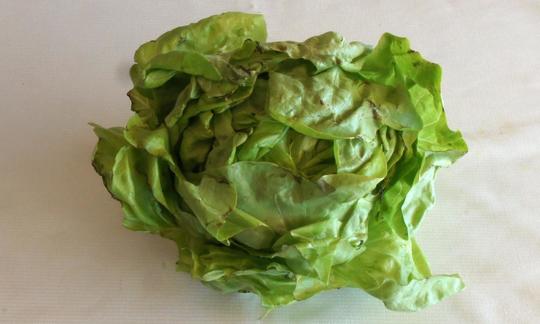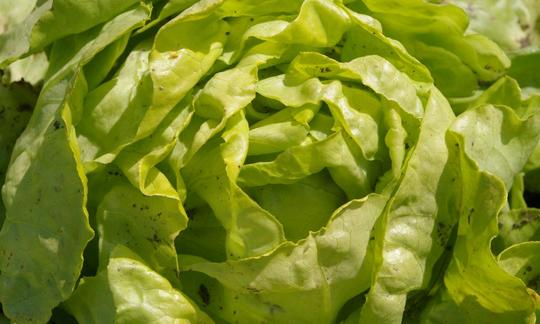Table of contents
Butterhead lettuce (Lactuca sativa var. capitata, Butterhead group ) is particularly suitable raw for mixed salads. Along with iceberg lettuce, it is one of the most popular salads on the European market.
Use in the kitchen
Lettuce has large, soft leaves that are slightly oily. Its taste is fresh and sweet. It therefore differs greatly in texture and taste from iceberg lettuce , Batavia lettuce or romaine lettuce . Lettuce does not always have to be green; there are also varieties where the leaves are red-brown.
Butter lettuce is usually eaten raw. It combines well with radicchio , alfalfa sprouts , arugula , garden cress or watercress . Vegetables such as radishes , peppers , tomatoes , cucumbers ,corn or red onions liven up the raw salad with beautiful colours. A topping of pumpkin seeds , linseed or sunflower seeds gives the salad a crunchy, nutty addition. An oil-free salad dressing can easily be made with walnuts , either as a light vinaigrette with balsamic vinegar or as a dressing with orange juice and ginger . Optionally, an oil-free dressing can also be made from avocado and lemon .
Lettuce leaves can be used as a substitute for savoy cabbage leaves, e.g. for roulades with Hokkaido and quinoa filling or red lentils, carrots and ginger . Unlike savoy cabbage leaves, you do not need to blanch the lettuce leaves beforehand. The lettuce leaves are also a great alternative to rice paper and corn tortillas for making summer rolls and tacos. Steamed lettuce is prepared like chard , savoy cabbage or spinach (e.g. with a little vegan oat cream ). Lettuce is a popular ingredient in raw vegan smoothies, e.g. with apple and bananas or beetroot and orange .
Vegan recipe for potato and lettuce soup
Ingredients (for 4 people): 200 g floury potatoes , 1 onion , 1 lettuce, 600 ml vegetable stock , 150 ml oat cream , salt andpepper .
Preparation: Peel the potatoes and dice them. Peel and chop the onion. Put the potatoes, onions and vegetable stock in a pot and simmer for 10-15 minutes - or until the potatoes are soft. Wash the lettuce leaves, drain well and cut into strips. When the potatoes are soft, take the pot off the heat and add the oat cream and lettuce strips and puree everything finely with the hand blender. Season with salt and pepper. The soup should not be left to stand or cook for too long, otherwise it will lose its light green color.
Vegan recipes with lettuce (raw) can be found under the note: " Recipes that have the most of this ingredient ".
| Not only vegans or vegetarians should read this: Vegans often eat unhealthily. Avoidable nutritional mistakes . |
Purchasing - Storage
Fresh lettuce can be found in large supermarket chains such as Coop , Migros , Denner , Volg , Spar , Aldi , Lidl , Billa , Rewe , Edeka or Hofer , mainly in green. Organic supermarkets such as Denn's Biomarkt or Alnatura always offer organic lettuce and often with red leaves. In addition to whole heads, there are also just the hearts or butterhead lettuce prepared and wrapped in plastic and ready to eat. We recommend always buying lettuce unpacked, preferably at weekly markets when in season, directly from the farm or via subscription boxes.
The availability of lettuce in the supermarkets mentioned varies depending on the size of the store, catchment area, etc. Our recorded food prices for the DA-CH countries can be found above under the ingredient image - and by clicking you can see their development at various suppliers.
In Central Europe, lettuce is harvested outdoors from May to September . Outside of the season, the lettuce is grown in greenhouses. This is why it can be found in stores almost all year round. 1
Storage tips
Lettuce is sensitive to pressure and cannot be stored for long. If stored in the vegetable compartment of the refrigerator and wrapped in a damp tea towel, lettuce will keep for 1-2 days after harvesting. 1 If the leaves are wilted, have a dark color and an unpleasant smell, you should no longer eat the lettuce.
Wild
lettuce is a cultivated group of varieties of garden lettuce ( Lactuca sativa ), which does not occur in the wild. Cultivated garden lettuce can be traced back to several wild forms, with spiny lettuce ( Lactuca serriola ) being the closest relative. 2 This grows wild in the warm temperate zones of southern Europe and western Asia and is spreading further and further into northern Europe. 3
Ingredients - Nutritional values - Calories
Lettuce (raw) has a water content of around 96% and is very low in calories with 13 kcal per 100g. The protein content is low at 1.4 g/100g and there is hardly any fat either. Lettuce contains around 1.1 g of fiber and 2.2 g of carbohydrates per 100g. 4
Does lettuce contain vitamins? Raw lettuce contains 102 µg/100g of vitamin K (136% of the daily requirement). Romaine lettuce and rocket have a similar content. Kale (705 µg/100g) and chard (830 µg/100g) have high vitamin K values, both of which can be eaten raw as a salad. 4
Lettuce also contains vitamin A , with 166 µg per 100 g covering around 21% of the daily requirement. Romaine lettuce contains significantly more, with 436 µg/100 g, which covers 55% of the daily requirement. Carrots are known for their high vitamin A content, with 835 µg/100g they have almost twice the amount of this vitamin. Raw sweet potatoes also contain a lot of vitamin A (709 µg/100g, 89% of the daily requirement). 4
Lettuce is known for its high folate (folic acid) content. 100 g of raw lettuce contains 73 µg, which is 37% of the daily requirement. Romaine lettuce (136 µg/100g) and endive (142 µg/100g) contain significantly more folic acid, which can cover around 70% of the daily folic acid requirement. Young spinach contains even more folate, as it is also eaten raw as a salad. Raw spinach contains 194 µg per 100 g, which covers 97% of the daily folate requirement. 4
The complete ingredients of lettuce (raw), the coverage of the daily requirement and comparison values with other ingredients can be found in our nutrient tables. In the article Nutrients explained you will get a detailed insight into the topic.
Health effects
Is lettuce healthy? Lettuce is rich in vitamin K. The body needs this vitamin for blood clotting. It also prevents calcium deposits in soft tissues and supports the regulation of cell processes (e.g. cell division). Vitamin K also inhibits bone loss, because the enzyme osteocalcin, which regulates bone mineralization, is dependent on vitamin K. 6
Lettuce contains secondary plant substances such as flavonoids, phenolic acids, tocopherols, etc. The content of bioactive compounds varies greatly depending on the type of lettuce. There are some in-vitro studies that show that lettuce (and extracts) improve the antioxidant status, suppress inflammation, prevent diabetes, inhibit specific cancer cell lines and have an antiviral effect. However, there are hardly any preclinical and clinical studies on this. In addition, measures before and after harvesting have a significant influence on the bioactive conditions contained in the lettuce. 22
Dangers - Intolerances - Side effects
Like other leafy and root vegetables, lettuce contains nitrate, which it needs as a source of nitrogen to grow. Nitrate can be converted to nitrite in the body and in food. 5 Nitrite can react with amines or amides produced by the body or ingested with food to form so-called nitrosamines, which are considered carcinogenic. 6
Nitrate from vegetables is considered safe for infants and small children (1-3 years) in normal quantities. Nitrite can pose health risks for infants (a few months old), but there are hardly any infants who eat vegetables contaminated with nitrate or nitrite at this age. 6,15 Nitrate from vegetables also has positive effects on health (for more information, see Batavia lettuce ).
If you want to consume as little nitrate as possible, you should eat seasonal organic lettuce or prefer iceberg lettuce and radicchio, as these have a low nitrate content in contrast to other leaf lettuces. 14
Ecological footprint - animal welfare
The carbon footprint of lettuce depends on the country of origin and the method of cultivation. For example, emissions during transport are significant for imported goods from Spain, and when grown in unfavorable climatic conditions, the heating of greenhouses has a negative impact on the footprint. 16 However, in a study on the ecological impact of lettuce production, growing in greenhouses proved to be the most harmful method of cultivation compared to growing in the field or under polytunnels. 17 The ecological footprint of lettuce is recorded in the climate database as 0.59 kg CO 2 eq/kg, but information on regionality and cultivation method is missing here. 18
The amount of water needed to produce 1 kg of lettuce is 237 litres. This is slightly less than the amount needed to produce 1 kg of spinach (292 litres) or cabbage (280 litres). 19
Lettuce plants are very susceptible to pests and diseases such as fungal infections, viruses or bacteria. An efficient way to prevent infections by unwanted pathogens is to remove crop residues. However, this practice is time-consuming and is not used very often. Alternating the cultivation of different crops also helps to reduce the harmful effects of diseases and at the same time promotes diversity in ecosystems. 20 In conventional agriculture, synthetic herbicides and pesticides are usually used to control pests. These are often found in the end product, 21 which is why people look for organically grown goods when shopping.
Worldwide occurrence - cultivation
Lettuce emerged as an independent group of varieties in the 18th century. The popular Bibb variety was bred in the USA in the 19th century. It is smaller than the Butterhead or Boston varieties. 10
Lettuce and other leaf lettuces are grown worldwide, with China, the USA and India being the main growing areas in 2020. In Europe, lettuce and other varieties are mainly produced in Spain, Italy, Belgium and France. 13 Lettuce is the second most popular lettuce after iceberg lettuce in Switzerland 11 and Germany. 12
Cultivation - Harvest
Lettuce is easy to plant in a garden bed, balcony box or pot. It prefers a sunny location. The soil should be loose and permeable, and have a high humus and nutrient content. Acidic soils should be avoided. Lettuce can be grown indoors or in a greenhouse from the end of February and planted out in the garden from the beginning of March. From the beginning of April to the end of October, lettuce can be sown directly in the garden bed. It is important to use seeds that are suitable for the season, otherwise the lettuce will shoot too quickly. Lettuce germinates at temperatures of 15 to 18 °C. To grow your own lettuce, scatter the seeds in seed furrows 0.5 to 1 cm deep and 25 to 30 cm apart. Lettuce germinates in light, which is why it should only be covered very lightly with soil. Young plants are very sensitive, they should be separated and not planted too deep. It is worth buying young plants to get a head start on growth. Regular watering, removing weeds and loosening the soil is important for the lettuce to grow well. 7
After a relatively long cultivation period of eight to ten weeks, the lettuce is ready for harvest. 7 Production is complex because the lettuce cannot (yet) be harvested by machine. At the moment, the lettuce is still harvested by hand. 8 As soon as the leaves around the head are fully developed, the lettuce can be harvested as a whole. To do this, use a sharp knife to cut off the head and stalk just above the ground. 7
Organically grown lettuce contains lower nitrate levels than conventionally grown lettuce because synthetic nitrate fertilizers are not used. Seasonal organic lettuce grown outdoors also contains less nitrate than lettuce grown in a greenhouse because sunlight breaks down the nitrate stored in the lettuce. 9
Further information
Lettuce (Lactuca sativa var. capitata L. ) belongs to the genus of lettuce ( Lactuca ), which belongs to the daisy family (Asteraceae). Cultivated garden lettuce is divided into several groups: Butterhead group (lettuce), Crisphead group (iceberg lettuce and Batavia lettuce), and Cos group (romaine lettuce). Cut and picked lettuce (e.g. oak leaf and Lollo rossa/bionda) are also becoming increasingly popular. 7
Alternative names
Lettuce is also called butter lettuce or head lettuce. In the USA it is called butterhead (butterhead lettuce or butter lettuce), or it can be found under the variety name Bibb or Boston Lettuce (types). In the UK it is usually called round lettuce. Red leaf lettuce in general is read leaf lettuce in English.










Comments